|
From
"Kid's Vid" to Network TV Special and Major Label
Album...
It was Christmas for almost two years straight!
The
journey from Eugene to Hollywood started with a handshake
agreement to do the soundtrack music for a very local made-for-video
thriller by first-time filmmaker, Jim Jaqua. I wish I could
remember the name of the video, but I do remember that it
had a ghost in it. I did it on a lark, for no money, and
just for the fun and challenge.
As often happens when you do something nice for someone,
kismet stepped in at the “preview party” where everyone
who worked on the project gathered to watch the film.
It turns out that the cameraperson on this project
was a tall, mountain/hippy looking guy with a soft voice
and ready smile named John
Logue. In making conversation after the video was debuted,
John mentioned that he and a friend, Ralph
Liddle, had just been hired to write and produce a children’s
video for Will Vinton Claymation in Portland. He further
suggested that I submit something to he and Ralph, as they
were looking for someone to do the music for this video.
Upon further discussion, John told me it was going to be
a fun spoof on traditional Christmas carols, and the initial
script had a running joke in it about pigs and dogs mixing
up “Here we come a Wassailing” with waffling and wallowing.
I asked him when they were making the decision, and he told
me “this coming week.”
Swell…no pressure there.
However, at the time I had an 8-track production studio
I used for recording radio spots for my advertising agency
(my real job), as well as creating jingles on the side,
under the DBA of “The Music Factory.” So, the next day (Sunday),
I went to work, turning out a couple of renditions of pigs
wallowing and dogs waffling to the modified tune of “Here
we come a Wassailing.”
I called Vinton’s studio on Monday, and met with John and
Ralph on Tuesday. Ralph
was a small, bespectacled guy with a wry wit and sense of
irony. He kept telling me that he was surprised to be doing the project,
as he and John had spent the last five years trying to get
wider release for their independent film “Spirit of the
Wind,” a story about dog sled legend, George Attla. Tales
of winning “best picture” at the US Film Festival, with
the extended problems of the business of distribution took
up the better part of the first hour of conversation.
We finally put on the demo tapes, and John and Ralph both
laughed excitedly…and told me “you have the job, if you
can meet our budget.” It was at this time that I got a hint of what
was to come when it came to dealing with Will Vinton Productions
budgets. There was a prevailing attitude at WVP in those
days that anyone working on a WVP project should be happy
for the experience. “It was about the art, not the money”
and most everyone who worked for the studio on this project
were working at what could be generously called, “intern
wages.”
The
few “long time employees,” those who had been with Vinton
since his Academy Award for his Claymation short, “Closed
on Mondays,” and through his larger budget feature, “the
Adventure of Mark Twain” and into his recent success with
commercials for The California Raisin Board and Dominos
Pizza, did not discuss wages. You could tell they made more…but
it was obvious that nobody was living in a lap of luxury
made of clay.
So,
when the list of songs was floated, it included 11 cuts
of music, at a flat-rate deal of $4,500. They agreed to
a deposit of $1,250, with the remainder to be paid and delivered
before May 1st, 1987, when I delivered the final
tracks. It was March 2nd, so there was very little
room for error, or loads of retakes.
I was satisfied that I could do most, if not all
of the music in my studio, with my own gear, and a small
number of hired voices. With a check the same day, the deal
was signed, sealed and delivered…and I went a wassailing
back down I-5 to my home studio to work.
The
process for creating and finishing a song for this project
was beyond miraculous. Their intent was to have all of the
finished music done by May 1st, so their animators
had a chance to animate to the basic tracks, and then all
of the finishing tracks, sound effects, and voice-overs
could be cut into the final pieces. Upon touring the facility,
it was evident that much of the basic animation had already
begun in regards to creating sets, and initial sculptures
of the key characters.
For
the next 6 weeks, I traveled back and forth up I-5 for several
meetings with set producers, Ralph, John and Will, who seemed
to have more of an “executive producer” role, not taking
much "hands-on" time with the project at all.
It was obvious that Ralph was the key component to the script
and flavor of the piece, and John had the artistic overview
of “the look” of the scenes, and overall feel of each segment.
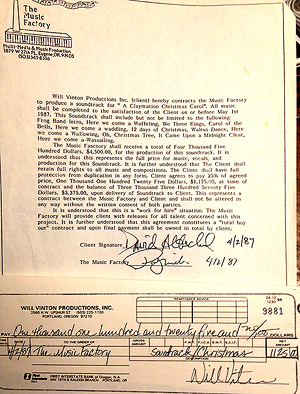 The
initial list of music included the following sequences. The
initial list of music included the following sequences.
1. Frog Band Intro
to Here we come a Waffling
3.
We Three Kings
4. Carol of the Bells
5. Here we come a Waddling
6. 12 Days of Christmas
7. Walrus Dance (Angles we have heard on high)
8. Here we come a Wallowing
9. Oh Christmas Tree
10. It Came Upon a Midnight Clear
12. Here We Come a Wassailing
Again…it
is important to remember that this was meant to be a children’s
Christmas carol video, much like the kind that Will’s wife,
Susan Shadburne was producing in the “Wee Sing” series (in
production around the same time). I saw it as a fun project,
with a little money on the side. Little did I know what the next few months
had in store for me.
Within
the first month, the script had been rewritten to be more
of a spoof, featuring Herb and Rex, two dinosaurs fashioned
loosely on movie critics Siskel and Ebert. Two songs had
been scrapped, “The 12 Days of Christmas” and “It came upon
a midnight clear” to make room for dialogue. It was at this
point that things made a change toward the “hip” and away
from the kiddy video that was the original intention.
John
and Ralph asked me to come up with a unique take on “Joy
to the World.” Joan
Gratz, who had been nominated for an Academy Award for
her beautiful clay painting short film “Creation” was supervising
a clay painting sequence for “Joy” and wanted something
different. Everyone was vague on details, but wanted something
that melded a variety of ethnic musical styles together
with a rock undertone. OK. Sure. Sounds simple.
The worst part of doing music for hire, is that everyone’s
opinion is subjective at best. Nobody hears the same piece
the same way as others. I had horror stories in the advertising
world of doing music and sound effects for ad agency wonks
who could only describe things in an extremely ethereal
manner. “Could you make the sound of that hammer more blue?”
was one of my favorites. Or
listening to an ad creative director make a poor, elderly
man with a wonderful unique voice do 47 takes on the line,
“Dairy Mart, convenience that is right in you neighborhood,”
because he couldn’t seem to hit the correct inflection on
the word, “right.”
So,
to say that doing an original version of a traditional song,
with several styles of music in it was challenging, daunting…and
as it turned out…fun. I figured I had nothing to lose, and
decided to just do something that I liked.
It
began with a huge, blasted pipe organ, playing the opening
refrain of the original song…but as the opening note sustained,
a basic Afro/Latin beat began underneath. A blues harp came
in to let you know that this was no longer going to be anything
resembling the original song…and we were off.
On
the next meeting I played the track for Ralph and John and
was told to wait while Will listened to it. Upon being summoned
to Will’s upstairs office, there was a change in attitude
and interest by everyone in the room. “What do you think
about redoing some of the other music to make them cooler,
and hipper…like this song you just did?”
My enthusiasm for their universal adulation of “Joy” overrode
the business side of my brain, and I simply said, “Sure!
Sounds like fun!”
The next song to be remodeled was turning “We 3 kings” into
more of a romp, with a battle of styles between the camels
and the kings. I was admittedly getting swept up in the creative
energy of WVP and the staff that worked there. It was amazing
to be part of the process, and see the incredible creativity
and detail that went into every set, vision, and story character.
We
didn’t talk money, it just didn’t come up…even though I
realized that I was in essence going to be redoing almost
all of the work I had already completed. Furthermore, it
all had to be done on an even tighter timeline, as the animation
process to render even a single frame of film at 24 frames
a second, could take hours, and my music was the basis for
the initial animation.
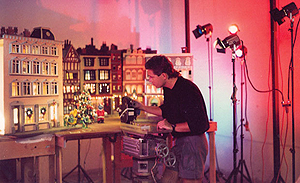 Street
Scene from Claymation Christmas Celebration
Street
Scene from Claymation Christmas Celebration
With Herb and Rex
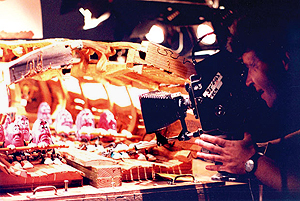
Raisins from California Raisins TV Commercial |
Watching
the process unfold over the course of the coming weeks was
amazing. Each set, each character, and every move of the
cast in each scene was done by the slightest of moves in
each frame of video. When you have a crowd scene, with a
camera doing a "flyover" of the village, the number
of moves each piece of the action must make, ALL IN CLAY
mind you, staggers the imagination. Like so many aspects
of the modern digital world, claymation is an artform that
has been bypassed for the most part by the power of computer
graphics. But, there is something visually stunning about
actual three-dimensional characters, with natural light,
coming to life under the careful and patient touch of a
stop-motion animator.
The
process for each song/segment became standardized. They
would give me a rough idea of the length of the piece, and
then provide me with copies of their “animatics,” which
were cartoon renderings of the storyboard for each piece.
This gave me an idea of the action, and the approximate
time that each part of the action hit in the timeline of
the extended piece.
I would then compose and produce a rough track with scratch
vocals, that gave them something to work with in regards
to animating to the song. Sound effects, and final voices
and musical hit points were added upon getting a copy of
the final version on VHS tape.
Now…here
is the amazing part, for any of you who understand current
production techniques with computer music rendering and
video/film conversion. This was all before there was a standard time
code in place for digital production. For the most part,
people would use one channel of the recording camera to
lay down a 60-cycle tone, that they could lock together
with the audio source. So, when you see someone doing the
“clap board” before there is “Action!” yelled onthe set,
they are setting a visual cue that could be locked to the
audio that was being recorded separately. Hit and miss
at best…
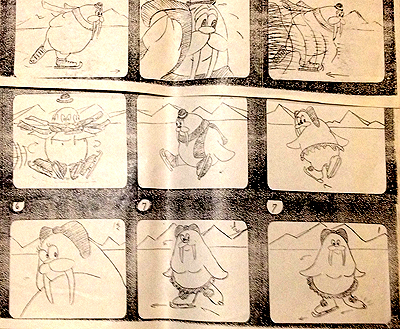 Actual
animatics used for Walrus Dance to
Actual
animatics used for Walrus Dance to
Angels We Have Heard on High |
At
about the same time that I got the contract with WVP, I
met an amazing computer genius named Robert
Keller. Robert had created a 48 track MIDI (Musical
Instrument Digital Interface) computer program, that allowed
you to play music with a MIDI keyboard or drum pad, and
it would record the notes as digital events that could then
play back the song on the keyboards attached. The things
that made Robert’s 48 track sequencer unique, was that it
not only had 48 tracks, but that the resolution of each
event was 1/300th of a second in accuracy. Other
programs were typically at a clock rate of 64 pulses per
quarter note, which had a tendency to make drum parts, or
parts played “outside the beat” (as much of blues and jazz
is), to be replayed in a rigid “quantized” manner.
But the key to this program’s value for me, was that
it allowed it to be locked to a SMPTE time code…the new
digital time code that was just starting to be used by high
end movie production studios in Hollywood.
This meant that I could create a piece of music- and then
be able to manipulate it to specific hit points for video
cues, without it sounding cut, or edited.
Before this time, soundtrack composers had to use
something called “The Book,” which was nothing more than
a huge list of math/music equations that gave them an idea
of being able to write a song in a certain time signature
to meet a specific length of time in the action of a film.
I hated math. Robert Keller was a lifesaver.
He
was also one of the most eccentric geniuses I have ever
met (including the staff at WVP). He rented a house down
by the campus of the University of Oregon, so he had a place
to work on his computer programming. He wanted to save money,
so he never turned on the heat. Ever. Plus, as he
explained, “it helped keep his heavily modified computer
cool.” I can tell
you that on several meetings, I could almost see my breath.
Robert was key to the success of this initial project, and
the extended project. Unlike buying a product off of the
shelf (and there were only a few basic products on the market
anyway), Robert was more than open to suggestion on what
would make his program "the best." I would give
him a call, asking about some need that had come up, or
some feature that would be nice in regards to organizing
the music, or adding flexibility to the production process,
and he would call the next day to tell me to “come by and
pick up a new floppy disc update.”
Amazing.
Around
the end of April, shortly after dropping off “Joy” and starting
the reworking of some new pieces, I got a call from Ralph.
“We sold it to CBS…it’s going to be on television. We have
to redo some music, and cut it down to 24 minutes.”
Yay!!
Oh crap.
The
Raisins jump on board
I was blown away by the prospect, to say the least. Suddenly,
the fact that this project really anchored on my music,
and the music was going to have to be redone again, was
daunting. Luckily for me, I had a steady income from a handful
of advertising clients for my advertising agency, and for
the most part, the workflow was just “one more thing to
record” on any given week. Most of the radio spots were
done prior to the weekend, and so that pretty much was a
single day of production and delivery of spots. This left
the rest of the week, and the 24-hour cycle of time, to
create, produce and drive up and down I-5 (4 hours of travel
round trip).
I was about half-way into re-cutting and reworking the music,
when I got another call from Ralph that Will wanted to meet
with me.
When I got into his office, he told me how pleased he was
with my work, and that he realized that the entire flavor
of the project had changed several times, due in part to
my music.
Flattering.
OK…so?
”We are bringing the Raisins into this, and I’d like to
have them do the Temptation’s version of “Rudolph.”
Would you be open to going to Hollywood to help negotiate
the song rights with Motown?”
The excitement of the concept once again overwhelmed my
common sense…and I said, “Sure! When do we leave?”
It wasn’t until Ralph and I had time to talk about the project
on the plane ride to Burbank, that I started connecting
some of the business dots. I realized that I was going to
have to re-cut and re-edit everything again, to now make
room for the Raisin’s piece, and I was still operating under
the original $4,500 contract.
Ralph was very up front about budget restraints, but told
me in no uncertain terms that I needed to renegotiate my
“deal.” Especially since this had gone from a low budget
kid's video, to what was now going to be a nationally broadcast,
major network television special (with an obviously larger
budget and payoff). Staffing was being added, expectations
were rising, and I was still working within a budget that
basically was going to pay roughly $375 per finished piece.
OK then…
Upon getting to Burbank, Ralph and I were ushered into Barry
Gordy Junior’s outer office, where we waited…and waited
and waited. Two very white guys…in a setting completely
filled with black workers, musicians, and executives. We
stood out.
Finally we were ushered in, the basics of the deal were
pitched and agreed upon within about 10 minutes, and we
were back on our way to Portland. As it turns out…the song, and the entire “California
Raisins franchise” became a point of contention that hounded
the project in later months and years. But, at the time,
we were just happy to have the deal done.
Without
going into detail, and avoiding any chance of slander regarding
the subsequent budget negotiations, I scheduled a meeting
with the business director, David Altshul. Every creative
type needs a David Altshul.
A guy like David allows the “star,” in this case
Will Vinton, to be happy, jovial, fun, and full of creative
energy, while all of the details, negotiations, and “Scrooge
tendencies” fall to the business guy.
When Will said, “talk to David about that,” it meant
“I don’t want to tell you the bad news…I have a guy for
that.”
Suffice
it to say, that I renegotiated a deal that was a little
more than twice the original contract, for about 8 times
the amount of work I had to do. I did get enough money out
of the “bump” to be able to get a new keyboard, a new mixing
board, and one of the new Fostex 16 track ½” tape recorders,
along with one of the first Sony 501 digital mastering recorders
(it recorded to VHS tape) in the country.
But, I made it clear, that any recording studio time
at an outside studio that had to be done on the “big budget
production number” for the Raisins, was going to be paid
directly by WVP. I’m
glad that part was included in the contract, as the bill
for final mixing at Spectrum Studios ran into the thousands.
Add to all of this, that we were in the process of moving
to a home in the country, and I was in the process of converting
a portion of a gigantic 4,000 sq. foot farm outbuilding
into a recording studio. No worries…who needs sleep?
The
last recording done in our home in Eugene, was to lay down
the final tracks on “Joy” including the amazing vocals by
Ron Tinsley, as well as the equally amazing sax solo by
Portland jazz great, Warren Rand.
Warren blew so loud and intensely, that I couldn’t
record him in the same room, but didn’t have an isolation
booth. So, we strung cables down to the laundry room of
the house, and Warren, the trooper he was, performed amongst
the laundry and cleaning products of the Miller household.
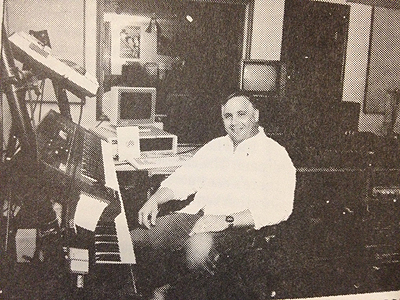 Finishing
the studio construction enough to get all of the new equipment
wired before the final cuts of music needed to be produced
was a chore and a minor miracle. My Dad, a carpentry wizard
with the patience of a saint, came down for a weekend and
helped me frame in the studio, control room, and isolation
booths. I sheetrocked and insulated for three straight days,
and then built custom cabinets to fit the gear. Finishing
the studio construction enough to get all of the new equipment
wired before the final cuts of music needed to be produced
was a chore and a minor miracle. My Dad, a carpentry wizard
with the patience of a saint, came down for a weekend and
helped me frame in the studio, control room, and isolation
booths. I sheetrocked and insulated for three straight days,
and then built custom cabinets to fit the gear.
The Claymation production, even with added staff and long
extended hours, was taking far longer than anticipated,
and even with an airdate of late December, it was looking
like it was going to be a push. As often as three times
a week, I was making the trip up and back to WVP. The modifications
and cuts were for the most part finalized by mid August,
with a guide track for the California Raisins parts in place
and being animated. However, one small detail remained…
I needed someone to SING the Temptations part.
I
auditioned several NW a cappella singing groups and narrowed
it down to a Eugene group, “The Tones,” and a Portland group
called the “Street Corner Singers.” Both groups had female
leads, something that the Temptations or the Raisins lacked.
In the end, I chose the Street Corner Singers, because they
had a better handle on the “Motown sound” and recording
time was booked at Spectrum Studios, with Mike Moore engineering.
The
session began by dumping my original 16 tracks of backing
music onto the 24 track. We then added sleigh bells, replaying
the bass part to fill it out, and then replaying the high
hat and snare parts, because Will (who was in the control
room at the session) insisted that it sound EXACTLY like
the Temptations version, and I had deviated from the very
straight 16th notes, to something with a little
more syncopation. Again… the boss is the boss…so we took
an hour (at $150 an hour) redoing the part.
When the Street Corner Singers arrived, they were excited
and nervous. Anita, their beautiful and talented lead singer,
was confident that they could make it work, even after I
asked her to “sing like a guy if you can.” She was more confident that the rest of the
group, who seemed put off that they had to match the Temptations
note for note, and were not able to put their own distinctive
sound on the tracks
.
The Street Corner Singers were talented,
and up to the task, once they got a handle on the parts
and harmony. Anita, Steve, Willie, Sunni, and Richard really
should have better acknowledgement on the record and the
television credits, but their manager and the group, were
insistent on being credited with the group name. I can’t
find their full names anywhere in my records, even though
I know releases were signed. One of those little things
that bugs me, every time I see the credits roll.
Upon the playing of the final mix at around 2am in the morning
with a session that started around 7pm, we were all pleased
with the result.
After
the “Raisin Session,” most of my time was spent on minor
tweaks and modifications of the music, right up until the
week before the airdate. While we had all seen bits and
pieces of the work as it was completed and shown to the
staff, nobody had seen a final cut. Will had become far
more “hands on” as the completion date loomed. There was
obvious friction between Ralph and Will, as Will insisted
on using his own voice on some of the characters, and ended
up adding computer digital effects which many (including
myself) beleived to have diminshed the impact of the clay
painting for “Joy” that was done by Christina Sells Tooke. But, Will was prone to leave his personal thumbprint
on the production (even including an attempt to play the
hi-hat part on Rudolph…which he abandoned after Mike and
I had to be blunt, regarding his random time keeping).
I didn’t witness this strange penchant first-hand, until
we were in the final mix of the sound, music, and film at
Pace Video, three days before the show was to be aired for
a national audience. During the final mix of the Walrus
Dance to “Angels We Have Heard on High,” there is a part
where the male walrus falls into a snow bank.
Will thought it would be funny to litterally bump
the master two-track music deck, to make the heads wobble.
I thought is was hack, juvinile, and sounded like
an editing mistake. You
can imagine who prevailed…and to this day, when I hear it,
I grit my teeth.
The
Press/Original Air Date
The
press running up to the special airing was extensive, both
locally and nationally. The national previews gave it high
praise, and there was an extensive interview for "Home
Recording Magazine." Locally, I had my 15 minutes of
fame, with interviews on a local TV talk show, a feature
story in the "Register Guard", as well
as one in 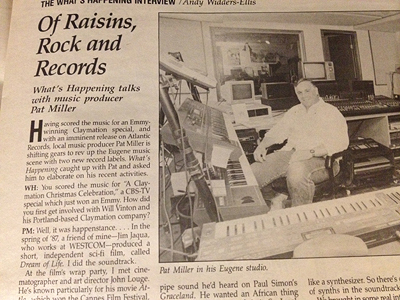 “What’s
Happening,” a local entertainment magazine. “What’s
Happening,” a local entertainment magazine.
All
fun, but I knew that when I did the math, this project probably
netted me around $.09 an hour. The slave wages paid to Nike
employees in Cambodia looked good in comarison.
But,
it was a great opportunity, and a wonderful experience for
the most part. You simply don’t get to work with such creative,
fun people, often. The staff was a bit of a family, including
a company picnic over the summer, and a softball game where
I hit two home runs (there were no fences…and they played
like animators) off of Will, who was of course, pitching.
We
watched the first airing, like most of America, in our home,
surrounded by friends and family. We had a 24” color TV…and
as you can imagine, as fast as 24 minutes flies by, in a
room full of excited people, the end result was fun, if
anticlimactic in regards to the almost full year of my life
that went into it..
When
the ratings came out the next week, we had not only won
our time slot, but were the top-rated special of the season,
even beating out the highly promoted and touted “Little
Match Girl” featuring “The Cosby Show’s” Keisha Knight Pulliam.
Ha! Take THAT Cosby!
CBS
was thrilled! We were thrilled! Everyone was floating on
a river of hope and promise- and slight letdown- as we realized
that this was the end of a huge project and a lot of fun.
CBS
followed up by agreeing to run the special for another 4
years, and ordering two more specials, one for Halloween,
and one for Easter.
The
Album…
It
was mid-April. I had settled into my daily routine of living
in Eugene, and was in the process of working on a music
production library for sale to radio stations. The Raisins
where not on my mind- I had moved on for the most part,
knowing that I may have a part in the upcoming specials,
but also knowing that there would be a ton of folks vying
for a chance to do music for WVP, including Cal Scott and
a couple of others who had done music prior to me.
“Pat,
can you come up and have a meeting with David and I tomorrow?”
It
was Will…and he sounded insistant, excited, and nervous.
Interesting combination.
When
I arrived at Will’s office, I simply walked up the stairs
to find him. I was long past the formality of waiting in
the main lobby, and waiting to be ushered in.
I had roamed freely around the production facility
halls for months prior, and always checked in with some
of the friends I had made during the production. I considered
Will a friend…but also knew it was in many cases a friendship
of convenience for both of us. He rarely let his guard down-
but, I understood the nature of being famous, and successful,
and running a business- even if I had not experienced any
of it myself.
Will
and David were in the office with a six pack of beers.
”I am flying to New York next month as the guest of Ahmet
Ertegun, to attend their 40th Birthday concert.”
”YES!!” My mind raced…but, wait…this is Will. There’s a
catch.
“They
want to do a record based on the show. Are you up for it?”
Will says gleaming, with David bobbing his head along like
a Cheshire Cat bobble head.
Again…common sense, and my business sense are in two separate
rooms…and I relply quickly to the affirmative.
Without taking this story to the extreme (which many would
say has already happened), I will do as they say in Hollywood,
and “cut to the chase.”
A
deal was reached. It wasn’t a great deal (again, this is
WVP), but I did get enough budget to make a record, using
the players I wanted to use, and retaining my publishing
rights when the record came out. I would take a minimal advance ($10K) by record
label standards, so it would take fewer pieces to recoup
the advance out of royalties, and thus, have a shot at actually
making some money on the project.
Here
was my reasoning…wrong or right.
In
the midst of the California Raisins flash in the pan, Priority
Records, a small independent label, had secured the
rights from the Raisin Board (the people who promote raisins
to the world…the edible kind), and had made an album of
cover songs, featuring Buddy Miles. For reasons that only
the gods of pop culture could begin to understand, the album
had gone platinum (a millon copies shipped and distributed). If we,
with the success of the TV show as a catapult, could capitalize
on the same concept with a major label behind us, we should
be able to do at least half of those numbers, even if it
was a Christmas record with seasonal shelf life. Atlantic told Will that they were going to
“press gold,” which meant they could ramp it up if it was
successful.
All good.
By
taking a small advance, just enough to cover actual production
costs, and not the lavish lifestyle of the average rock
star (which is where a lot of advance money usually gets
wasted), I was couching my bet to spend short, and collect
long over the lifetime of an album that would be supported
by at least 4 more showings on CBS.
What
could go wrong?
Oh…silly,
silly producer boy. So…many…things.
But
foresight is not hindsight, and looking back I couldn't
have predicted the future...or something like that. In any
case, I jumped into year two, of Claymation Christmas
Celebration Music.
I
fleshed out my studio with a few more pieces of gear, and
started calling up all of my favorite NW music artists to
seek their participation on the project. There would be
little or no royalties associated with the project for performers,
because the album was considered a soundtrack, and the “artist”
was WVP, so to speak. Any
royalties earned would be from publishing/performance for
the composer (me) and split with WVP and Atlantic (standard
in that day).
So,
the only thing I could promise the singers and players for
this project was union scale of around $75/$125 a session,
and some fame/exposure on a major record label.
Nobody
balked at the offer, even though I always felt bad explaining
the details. When I told them I was making nothing up front
(true) and was mostly spending the advance on equipment
and studio time (also true), people jumped on board with
the spirit of simply having some fun, and singing some unique
versions of christmas carols.
I
threw myself into creating music for the album at a pace
that was crazy even by my standards.
It was determined that only a handful of songs from
the TV special would translate well onto an album. The songs
were selected, and while I battled to keep “Oh Christmas
Tree” on the record, because it featured the voices of my
daughters Joni and Amy (11 and 9), I was overruled and the
"Carol of the Bells" was selected in its place,
with an overdub of my voice, explaining the action that
the listener couldn’t see.
The
full-length version of “Joy to the World” was on the roster.
This pleased me, because the TV version had been
edited for time limitations. “We
Three Kings Bop” made the cut, as it worked pretty much
intact without editing. An editing feat of tying together
the four versions of Wassail, Waddle, Wallow, and Waffle
into a cohesive story and single cut was achieved. And of
course, the “franchise team” of the California Raisins would
lead things off with “Rudolph.”
This
left a TON of space on a record--even in the days of vinyl
and cassette, which called for at least another seven cuts
to round out the album contract length of at least 35 minutes
of music.
I pulled out the original book of children’s Christmas carols
that I had used, as well as looking at the original titles
of the TV special, and took a long drive (my mind is most
creative when driving or in the shower...go figure) with
a cassette recorder by my side.
As I sung each of the songs, I searched for new phrasing,
and polyrhythms. I
thought about popular music of the day that was catching
my ear…the danceable grooves of Michael Jackson’s “Bad”
and the creative, ethnic synthesizer work of Peter Gabriel.
And then I started trashing tradition…
I
go into more detail on each cut on the “Album
Music Section” of this site- but I would like to add
some overviews and special memories.
 First-
my family was completely cool with Dad being buried in his
studio day and night for weeks. My daughter Katie, who was
not even two at the time, would be my frequent visitor.
By the time the project was finished, she knew how to operate
the basics of most of the gear in the studio.
She loved the dance grooves, and would sit at the
back of the studio in her own chair, listening to the songs
come to life. First-
my family was completely cool with Dad being buried in his
studio day and night for weeks. My daughter Katie, who was
not even two at the time, would be my frequent visitor.
By the time the project was finished, she knew how to operate
the basics of most of the gear in the studio.
She loved the dance grooves, and would sit at the
back of the studio in her own chair, listening to the songs
come to life.
I
got to work with some of the most talented musicians in
the Northwest, and their contribution to each track is what
makes them special. Terry
Robb, John Koonce, Marilyn Keller, Don Latarski, Linda Hornbuckle,
Jeff Homan and Calvin Walker were but a few of the players
and singers who took my strange, creative arrangements and
made them their own.
Bill
Barnette of Gung Ho (http://www.gunghostudio.com/) studios
in Eugene, became a backup set of ears when we moved much
of the vocal tracking and mixing to his state-of-the-art,
yet homey, backwoods studio. He was invaluable when it came to rounding
out the final sound, as well as making last minute suggestions
on finding phone numbers for singers and players, most notably,
Marilyn Keller, the amazing singer for Don Latarski’s jazz
trio.
Marilyn had the unbelievable ability to walk into the studio
cold, and add layer upon layer of perfect, beautiful backing
harmonies to anything I threw at her. Ron Tinsley could
do the same, and when brought together, they became the
defacto album “gospel choir.”
Ron
is one of my favorite singers I have worked with, in my
entire lifetime of singing and playing. He is laid back
with a Zen quality that brings peace and calm to any session.
His voice is as smooth as silk, with a combination of Motown,
Gospel and Jazz that makes him versatile. He carried the lead vocals on Joy, Hark!,
Good King Swing, and the lead camel on We Three Kings
Bop. His stacked vocals with Marilyn on the final
cut, Angels We Have Heard on High (with lead vocal
by Lea Jones of “the Tones), is something to which I never
grow tired of listening.
One
of my almost lifelong friends is legendary blues guitarist
Terry
Robb. An Oregon
Music Hall of Fame recipient, and winner of “Best Guitar
Player” for the “Muddy Blues Awards” from the NW Blues Association
so many times that they finally barred him from the ballot,
he is simply the best guitar player I have ever been around.
From the first time I met him, when he blew me away
by playing Robert Johnson lick for lick…at age 12... to
everything he has done since… I simply smile with joy at
every note he plays.
I
ended up being proud of the project, and had the most fun
taking basic mixes home for Debbie to hear, as we drove
around listening to them on the car stereo to get a feel
for the overall mix. It is still a recording project that
was unique, and much of it holds up today (while some sounds
extremely rooted in the 80s to me).
I could go on and on about my impressions of the record,
and the experience of recording it, but the fact is, it
was a project that brought as much disappointment as it
did pleasure. And that is completely on my own shoulders.
The
Emmy, The Release, and Leaving it all behind…
Unlike
the television project, which I did almost entirely on the
basis of "being a team player helping to make a great
product for the sheer sense of art and pleasure," I
went into the album project with mercenary intent. And as it turns out, the universe is funny
about slapping you down when your intent is wrong.
We
needed to deliver the product to Atlantic before mid-August,
and the deadline was met.
At about the same time, the Emmy Award nominations
came out, and we were nominated in the category of “Best
Animated Program.” As you can imagine, months of working
on a project with little or no money coming in from my advertising
agency to supplement the income, I was not too happy to
hear that I was welcome to go to the Emmy Awards with Will
and Company, as long as I paid my own way.
Classy.
The project was 75% music…my music…and I had to pay my own
way?
OK
then.
But,
I went.
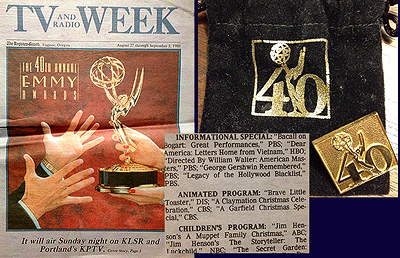 I
won’t belabor the point further- but if you would like to
read an irreverent account of the trip I wrote back in 2005, I
won’t belabor the point further- but if you would like to
read an irreverent account of the trip I wrote back in 2005,
you can find it here.
The highlights were:
1. We were in the untelevised part of the awards, and it
was obvious that the presenters didn’t want to be there.
2. It was held in what was essentially a convention center
warehouse.
3. We were the first award of the night, so we had to sit
there anticlimactically for the rest of the night.
4. Will Vinton only paid for a limo to take us to the awards-
we had to pay our own way back to Hollywood from Studio
City.
5. Will’s idea of celebrating the "apex of our careers,"
was to buy a case of wine coolers and try to convince me
to play Motown favorites on the baby grand in his suite.
6.
As I sat alone in the hot tub later on at the Sunset Marqui,
missing my wife…I heard gunshots in the neighborhood, and
realized I was “done with Hollywood.”
“Nuf said.
This was a perfect prelude to the fact that the record release
was delayed for almost two months, due to a legal battle
between the use of the Raisins on the cover of the album-
as Priority and Motown had strictly prohibited such by Atlantic,
and Atlantic and WVP had chosen to ignore.
This lead to late shipping of a holiday record, with a short,
seasonal shelf life. Suffice it to say, it did not “ship
gold,” and while there are significant
questions revolving around the number of units sold,
the number of units reported, and the number of units that
actually showed up on anyone royalty reports (welcome
to the record business, kid…), by this time, I felt
like I had sold my soul to the devil, and was acting as
such…including checking record sales reports on Christmas
Eve.
Argh.
Bad Daddy.
The
following couple of years were simply one big list of frustrating
events. We never got an accurate accounting of actual records
sold, and I never recieved a nickle from Atlantic. Not a
dime.
Almost 4 years later, I followed up with ASCAP about the
possibilty of trying to see if they had any sales numbers
that had been reported since I gave up trying with Atlantic.
They told me that none had been reported...HOWEVER...If
I was "The Patric J. Miller" that had done the
music for the original broadcast, they had been trying to
find me.
The
final "Christmas Surprise" to this long chapter,
was that they had collected, and were holding performance
royalties from the television broadcasts, as well as foreign
broadcast of the special, that came to a figure that was
several times what I had collected from either WVP or Atlantic.
The timing could not have been better, as the three years
following the release of the album, were some of the hardest
we faced as a family.
IN
RETROSPECT
So
much time has passed under the bridge that almost (almost…)
all of the bad memories of the album are fading, and I am
left with putting the album on the CD player once a year
and saying, “Hey…that is pretty damn original stuff!”
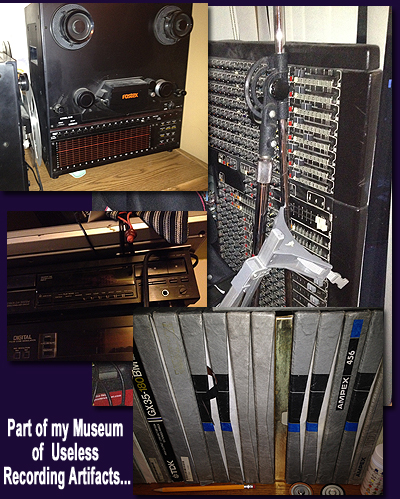 By
the number of people who seem to be trying to find copies
on Ebay, Amazon, and other collector sources, I would have
to say that Atlantic would be wise to make it available
again. But, in the
absence of common sense… By
the number of people who seem to be trying to find copies
on Ebay, Amazon, and other collector sources, I would have
to say that Atlantic would be wise to make it available
again. But, in the
absence of common sense…
I will, as one of the legal publishers listed with ASCAP,
make it available (for listening only...no file sharing
please!) on the pages following.
In the end…it was just a chapter in my life. Fun, crazy,
entertaining as hell…and unique. Like so many things in
this life, it is a chapter that served a purpose, but was
only a small part of a life well-lived. Looking back now,
it was amazing to accomplish what we did, with the equipment
and budgets I was using. We got every ounce out of every
dollar invested no doubt about it.
But, like so much of what we think was "state-of-the-art"
then, is just another relic sitting in the basement of someone's
life.
Case in point...while I can't bring myself to part with
my old analogue Fostex E-16 recorder, the 40 channel mixing
console or the stack of master tapes from that era, as at
the time, they were worth tens of thousands of dollars,
and were the life blood of my professional and musical existence,
today...they are just taking up space. Even more to the
point...the new self containted, 24 track digital recording
studio I recently purchased, that includes ten times the
features of my entire studio "back in the day,"
cost less than ONE of the microphones I used on this project.
It's an amazing world... the tools are there...the creativity
is boiling over...it's time for old guys with failing ears
(from too much loud music) to step aside for the next generation.
I'll
see you on the golf course!
|

